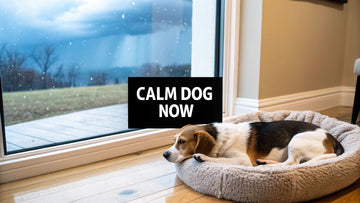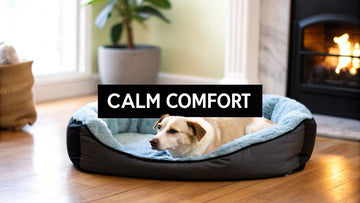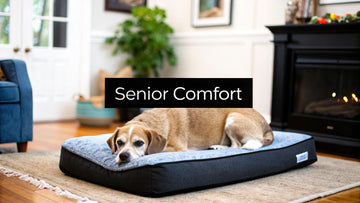Dogs communicate their discomfort in subtle and often misunderstood ways. While we wish they could tell us what's wrong, their stress manifests through specific behaviors and physiological changes. Recognizing these signs is the first crucial step for any responsible pet parent, as chronic stress can significantly impact their health, behavior, and overall quality of life. From loud noises like fireworks to major life changes such as moving, numerous triggers can unsettle even the most resilient dog.
It's crucial to distinguish stress from physical pain. While decoding your dog's silent signals for stress, it's vital to differentiate between behavioral and physical ailments. For instance, understanding how to approach recognizing subtle behavioral changes caused by conditions like arthritis can prevent misdiagnosis and ensure appropriate care.
This guide will walk you through 8 of the most common dog stress symptoms, providing a comprehensive look at what to watch for. We will explore not just the "what," but the "why" behind these behaviors and offer practical, actionable steps you can take to alleviate their anxiety. By learning to interpret their silent language, you can build a deeper bond and ensure your companion feels safe, happy, and understood.
1. Excessive Panting and Drooling
While panting is a normal way for dogs to cool down after a run or on a hot day, it can also be one of the most immediate dog stress symptoms when there's no obvious physical reason for it. This type of panting is a direct physiological reaction to anxiety or fear. It’s triggered by the activation of the sympathetic nervous system, often called the "fight-or-flight" response, which ramps up a dog's heart and respiratory rates.
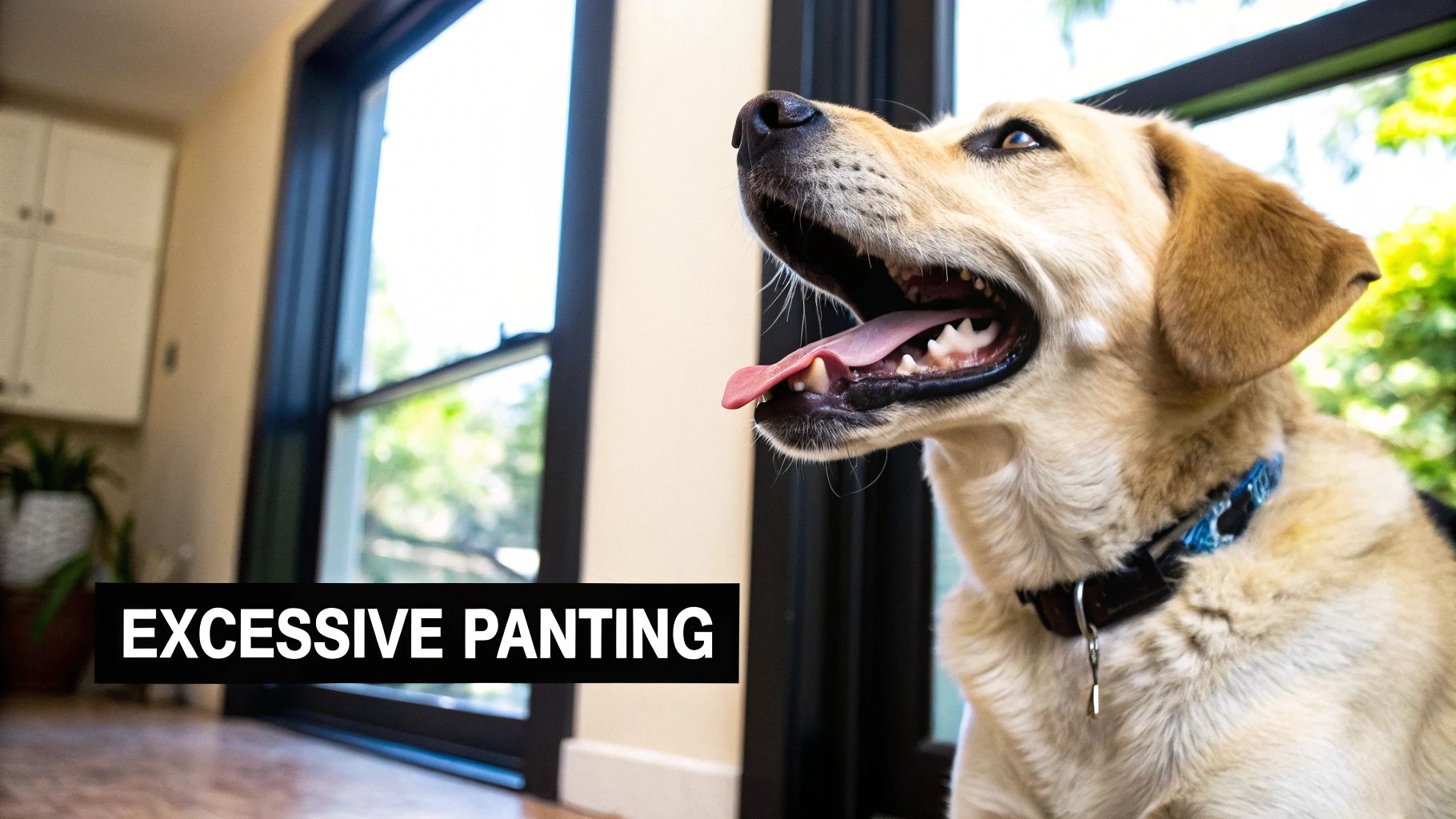
This stress-induced panting often appears more rapid and shallow than normal cooling panting. You might also notice excessive drooling or hypersalivation occurring at the same time, even in breeds not typically known for drooling. The dog's mouth might be held tensely, with the corners of the lips pulled far back.
Real-World Scenarios
Recognizing the context is key to identifying stress-related panting.
- During a Car Ride: A dog who isn't hot or thirsty but is panting heavily in the car is likely experiencing motion sickness or travel anxiety.
- At the Vet's Office: Many dogs begin to pant and drool in the waiting room, associating the environment with previous stressful experiences.
- Loud Noises: A common trigger, such as fireworks or a thunderstorm, can cause a dog to pant uncontrollably while hiding or pacing.
- New Environments: A newly adopted rescue dog might pant excessively for days as they acclimate to their new home and family.
Key Insight: Unlike panting from heat, stress panting isn't about thermoregulation. It's a visible, external sign of internal turmoil. Observing this behavior without an environmental cause is a clear signal to investigate potential stressors.
Actionable Tips to Help
If you notice your dog exhibiting these signs, your first goal is to de-escalate their stress.
- Remove the Stressor: If possible, immediately move your dog away from the stressful situation. This could mean leaving the dog park, ending the car ride, or moving them to a quiet, interior room during a storm.
- Create a Safe Haven: Guide them to their crate or a quiet room with their favorite blanket or toy. Familiar scents and a secure space can provide immense comfort.
- Offer Water: Stress panting can lead to dehydration. Ensure fresh, cool water is available, but don't force them to drink.
- Try Calming Techniques: Speak in a low, soothing voice. Gentle, slow-stroke massages along their back can also help calm their nervous system. Avoid frantic, high-pitched reassurances, which can escalate their anxiety.
2. Destructive Behavior and Excessive Chewing
When a normally well-behaved dog suddenly starts destroying furniture, shoes, or door frames, it's a significant red flag. This destructive behavior is one of the most misunderstood dog stress symptoms, often misinterpreted as simple mischief or boredom. In reality, it’s a physical outlet for pent-up anxiety, fear, or frustration, acting as a coping mechanism for a dog who feels overwhelmed.
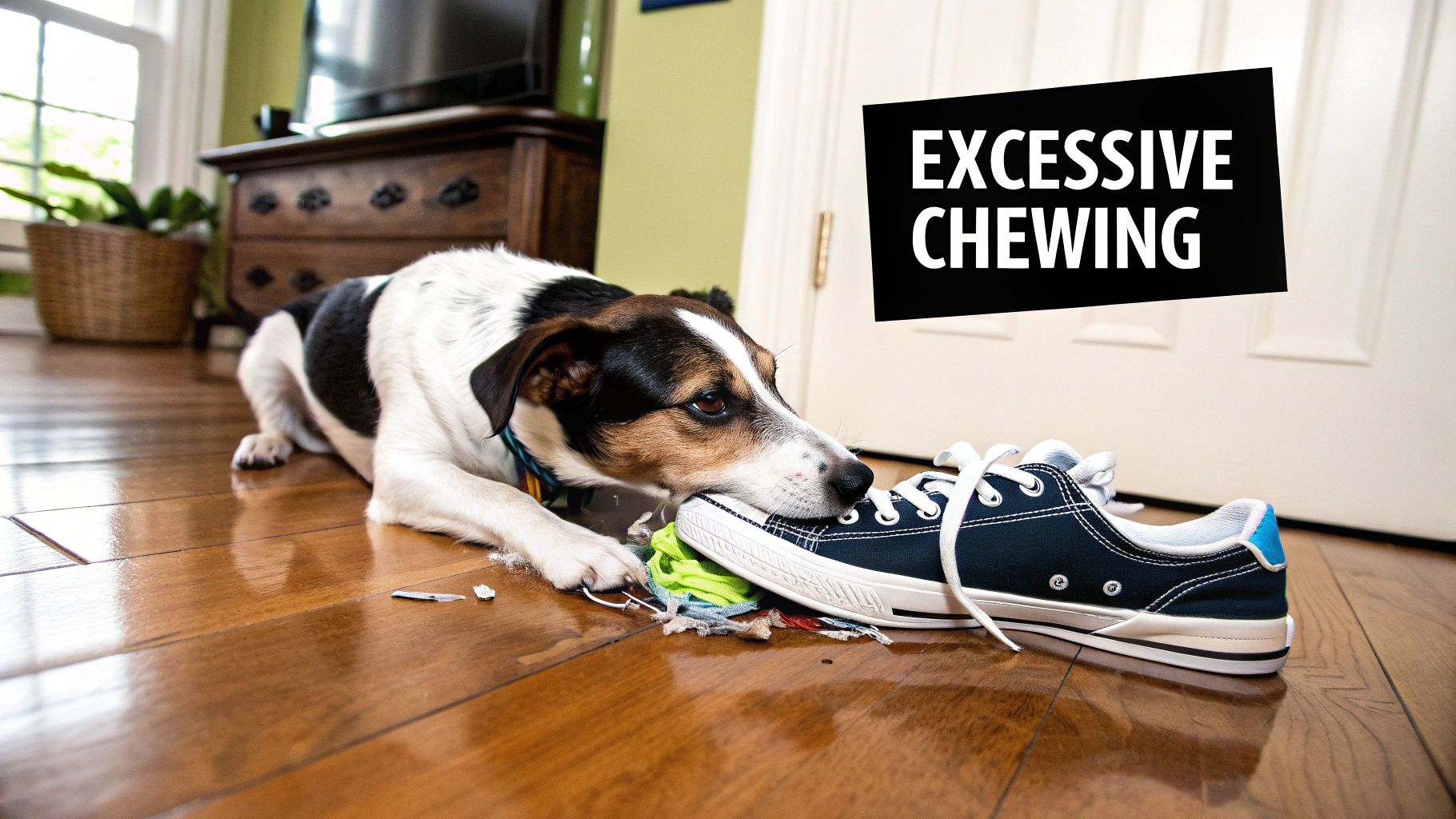
This isn't random destruction. Stressed dogs often target items that carry their owner's scent, like shoes or clothing, in an attempt to self-soothe. They may also focus their efforts on exit points such as doors and windows, a clear sign of separation anxiety or confinement stress. The act of chewing itself can release endorphins, providing temporary relief from their emotional distress.
Real-World Scenarios
Understanding the context of the destruction is crucial for identifying its root cause.
- Separation Anxiety: A dog chews on furniture legs or tears up pillows only when left alone, often within the first hour of their owner's departure.
- Noise Phobia: During a thunderstorm or fireworks, a dog might frantically scratch at doors or tear up their bedding in a desperate attempt to escape the sound.
- Confinement Stress: A dog who isn't properly crate-trained may chew on the bars of their crate or destroy any bedding inside it out of panic.
- Boredom and Under-stimulation: A high-energy dog without enough physical or mental exercise may resort to digging holes in the yard or shredding household items as an energy release.
Key Insight: The target and timing of the destruction offer vital clues. It’s not about spite or revenge; it's a dog's desperate, instinctual attempt to cope with intense feelings of anxiety or fear when they cannot find another outlet.
Actionable Tips to Help
Addressing destructive behavior requires managing the underlying stress, not just punishing the act.
- Increase Exercise and Enrichment: A tired dog is a less anxious dog. Ensure your dog gets plenty of physical exercise before you leave them alone. Provide puzzle toys or treat-dispensing gadgets to keep their mind engaged.
- Manage the Environment: Dog-proof your home by removing or protecting valuable items. Use deterrents like bitter apple spray on furniture and provide plenty of appropriate chew toys as an alternative.
- Gradual Desensitization: If separation is the trigger, start by leaving your dog alone for very short periods and gradually increase the time. This builds their tolerance and confidence.
- Consider Calming Aids: Creating a calm environment can make a significant difference. You can discover more about the best dog calming products on fluferstore.com to find solutions that may help soothe your pup.
3. Changes in Appetite and Eating Patterns
A dog's relationship with food is often a direct barometer of their emotional state. Significant changes in eating habits are prominent dog stress symptoms, manifesting as either a complete loss of appetite (anorexia or hyporexia) or, less commonly, compulsive overeating. This shift is driven by stress hormones like cortisol, which can suppress hunger signals or, conversely, trigger comfort-seeking behaviors.
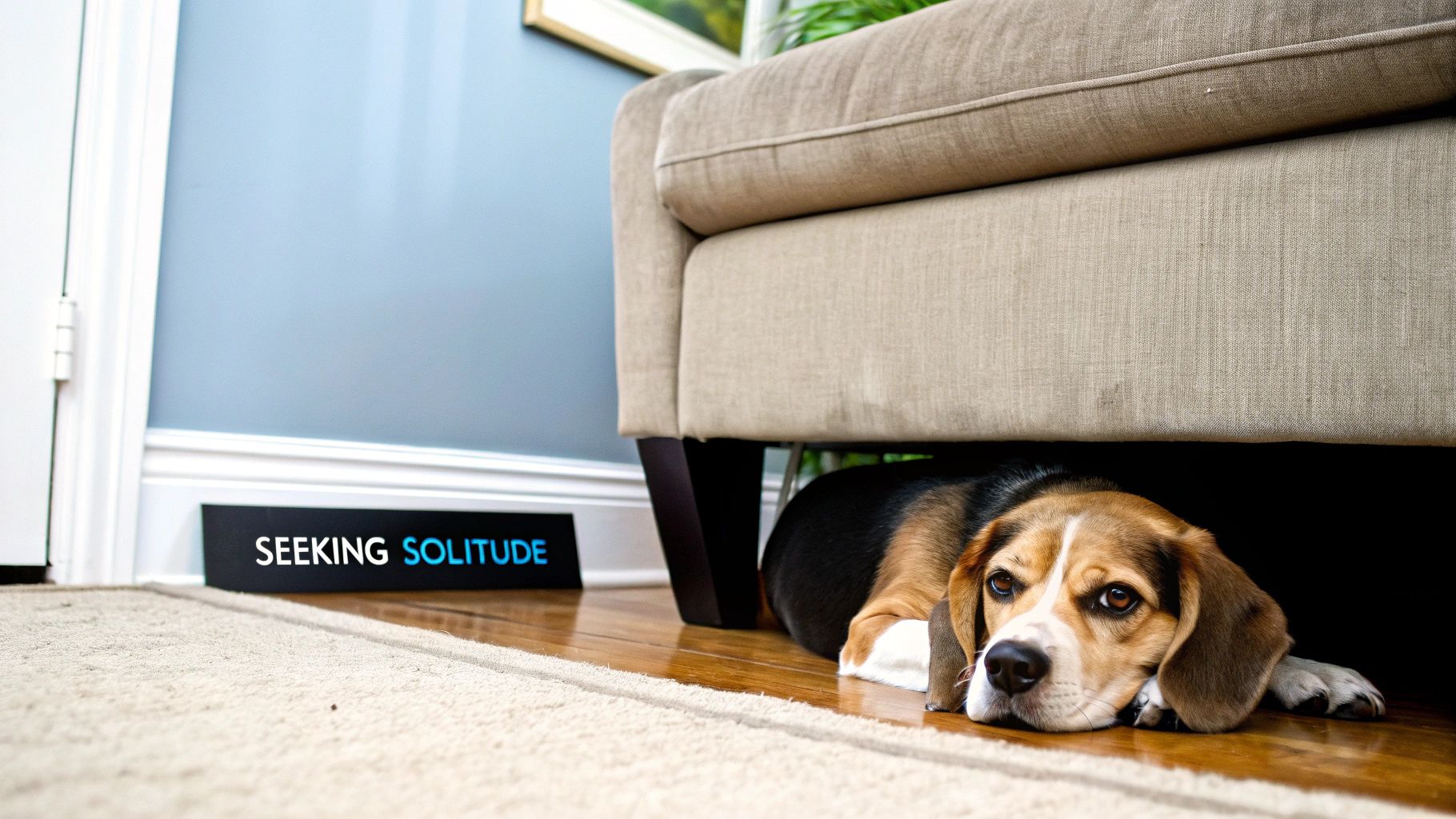
When a dog is stressed, their body enters a "fight-or-flight" mode, prioritizing immediate survival functions over processes like digestion. This can make the very act of eating feel unimportant or even unsettling. A sudden refusal to eat or a new tendency to gorge on food should always be taken seriously as it can signal underlying anxiety.
Real-World Scenarios
Observing when your dog's eating patterns change is crucial for identifying the root cause.
- Environmental Changes: A dog might refuse all meals for a few days after moving to a new home or if their owner is away on a trip.
- Separation Anxiety: Some dogs will not eat until their owner returns home, while others may overeat as a coping mechanism when left alone.
- New Family Members: The introduction of a new pet or a baby can create social stress, causing a dog to skip meals or guard their food.
- Chronic Fear: Dogs with a persistent fear of loud noises, like thunderstorms, may lose their appetite for the duration of the event or even the entire season.
Key Insight: Appetite changes are a powerful, non-verbal communication tool. A dog who suddenly stops eating is often sending a clear message that their world feels unstable or frightening.
Actionable Tips to Help
If your dog's eating habits change due to stress, focus on re-establishing security and routine.
- Maintain a Schedule: Keep feeding times and locations consistent every day to create a predictable and safe routine.
- Create a Calm Space: Ensure their feeding area is quiet and away from high-traffic zones. If you have multiple pets, feed them separately to prevent competition and stress.
- Encourage Eating Gently: Try hand-feeding small amounts of kibble to rebuild a positive connection with food. You can also mix in a small amount of high-value wet food or bone broth to entice them.
- Support Gut Health: Stress can wreak havoc on digestion. Adding a supplement can help maintain gut balance during anxious periods. You can learn more about probiotics for dogs on fluferstore.com for digestive support.
- Consult a Vet: If your dog refuses to eat for more than 24-48 hours, it's essential to contact your veterinarian to rule out underlying medical issues.
4. Excessive Vocalization and Whining
While barking and whining are normal parts of a dog's communication toolkit, a significant increase in vocalization is a key indicator among dog stress symptoms. This isn't your dog's typical "I need to go out" bark; instead, it's a persistent, often high-pitched expression of emotional distress. This anxiety-driven vocalizing is a cry for help, comfort, or a way to release pent-up nervous energy caused by an overwhelming stressor.
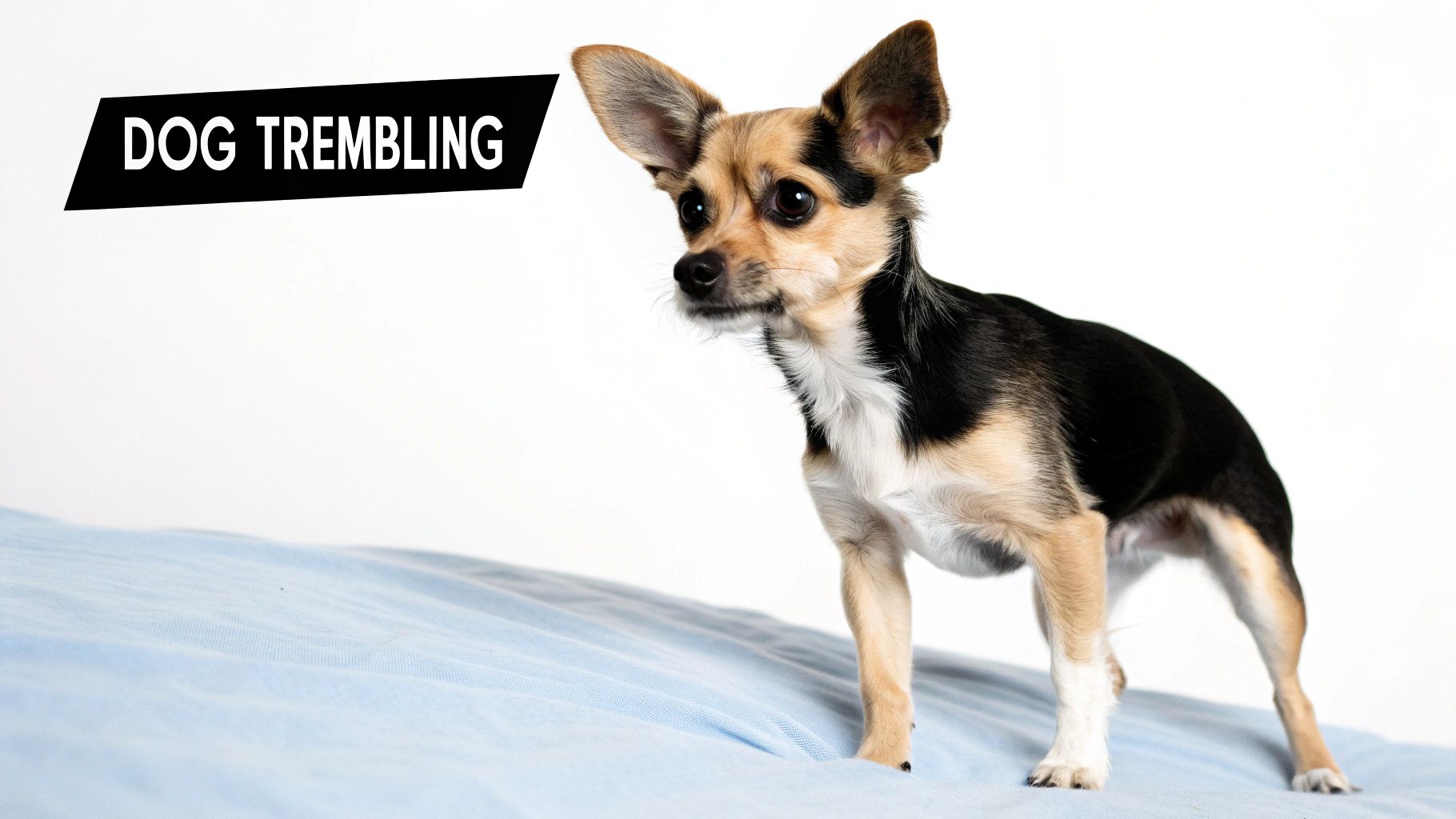
These stress-related sounds differ from normal communication in their intensity, frequency, and context. The whining might be continuous and high-pitched, the barking can sound frantic and repetitive, or your dog might even howl when left alone. These vocalizations often occur in situations where the dog would otherwise be quiet, signaling that their emotional threshold has been crossed.
Real-World Scenarios
Understanding the context is crucial for distinguishing stress vocalizations from regular communication.
- Separation Anxiety: A dog that howls, barks, or whines incessantly only when you leave the house is likely suffering from separation anxiety.
- Vet Visits: Continuous, low-pitched whining during a car ride that you know ends at the vet’s office is a clear sign of anticipatory fear.
- Thunderstorms or Fireworks: Excessive, panicked barking during loud events is a direct reaction to an acute phobia or fear.
- Presence of Triggers: A dog may begin whimpering or barking defensively when approaching a place they fear, such as a dog park where they previously had a bad experience.
Key Insight: This type of vocalization is not a behavioral problem to be punished, but rather an outward sign of internal anxiety. Addressing the root cause of the stress is far more effective than simply trying to quiet the noise.
Actionable Tips to Help
Your goal is to calm the underlying anxiety, not just silence the symptom.
- Don't Reinforce the Behavior: Avoid giving excessive attention, treats, or even scolding when your dog is actively vocalizing from stress. This can inadvertently teach them that making noise gets a reaction.
- Redirect Their Energy: Engage your dog in a calming activity before the stress can fully take hold. A puzzle toy, a simple training command session, or a gentle game can shift their focus.
- Reward Quiet: Use positive reinforcement. When your dog takes a breath and is quiet, even for a moment, reward them with a calm "good" and a small treat.
- Consider Calming Aids: In situations with known triggers, using tools like pheromone diffusers, calming music, or specialized supplements can help soothe their nerves. For dogs with persistent anxiety, exploring options like calming chews with melatonin might provide additional support.
5. Withdrawal and Social Isolation
When a dog that is usually sociable and interactive suddenly seeks solitude, it's a significant behavioral shift and a common sign of dog stress symptoms. Withdrawal is a coping mechanism where a dog removes itself from its environment to reduce sensory input and avoid perceived threats. This isn't just a desire for a quiet nap; it's a deliberate retreat from family, other pets, and activities they once enjoyed.
This isolating behavior can manifest as hiding under furniture, staying in a crate even with the door open, or retreating to a distant room. The dog is actively choosing to be alone as a way to manage overwhelming feelings of anxiety or fear. This change is particularly telling in breeds known for their "velcro" nature, like Golden Retrievers or Vizslas.
Real-World Scenarios
Understanding the context behind the withdrawal is crucial for identifying the underlying stressor.
- Household Changes: A dog might hide in a closet or under a bed after a new baby, new pet, or even new furniture is introduced into the home.
- Loud Events: During thunderstorms or neighborhood fireworks, a dog may retreat to a basement or bathroom to muffle the sound and feel secure.
- Visitor Anxiety: When guests arrive, a stressed dog might go to another room and refuse to come out, avoiding the unfamiliar people and increased activity.
- Chronic Pain: A dog suffering from an undiagnosed ailment like arthritis may isolate itself because it feels vulnerable or because movement is painful.
Key Insight: Withdrawal is a dog's way of saying, "I can't handle this right now." It's an attempt to regain a sense of control and safety by shrinking their world down to a small, manageable space.
Actionable Tips to Help
If your dog is isolating itself, your goal is to provide security without forcing interaction.
- Respect Their Space: Never pull a hiding dog out from their safe spot. This violates their trust and can increase their fear. Monitor them from a distance to ensure they are safe.
- Enhance Their Haven: Make their chosen spot more comfortable by adding a favorite blanket or a piece of your clothing. Ensure they have easy access to water nearby.
- Use Gentle Encouragement: Try sitting quietly near their hiding spot without trying to interact. You can toss a high-value treat in their direction to create a positive association with your presence.
- Maintain Routines: Keep feeding and walking schedules consistent. This predictability can be very reassuring. If stress is causing sleepless nights for both of you, you can learn more about how to calm a restless dog at night.
6. Trembling and Physical Shaking
When a dog trembles or shakes for no apparent reason, like being cold or excited, it's often a profound physical manifestation of anxiety. This reaction is one of the more overt dog stress symptoms, driven by an adrenaline surge from the fight-or-flight response. The release of stress hormones like cortisol and adrenaline causes involuntary muscle contractions, which present as anything from subtle tremors to full-body shaking.
This shaking isn't a conscious behavior; it’s a direct physiological sign that your dog's nervous system is overwhelmed. The trembling can occur during exposure to a stressor and may even continue for a while after the trigger has been removed, as the dog's body works to regulate itself and burn off the excess adrenaline.
Real-World Scenarios
Observing shaking in context is crucial for distinguishing stress from other potential causes.
- During Loud Noises: A dog hiding and shaking violently during a thunderstorm or fireworks display is experiencing acute fear and sensory overload.
- At the Vet's Office: Many dogs begin to tremble upon entering the clinic, a conditioned response to past experiences with examinations or procedures.
- Encountering Fears: A dog might start shaking when a larger, unfamiliar dog approaches or when faced with a feared object, like the vacuum cleaner.
- Anticipation of Stress: Some dogs will begin to tremble when they see you get out the nail clippers or start running the bathwater, anticipating an unpleasant event.
Key Insight: Unlike shaking from cold or excitement, stress-induced trembling is a clear indicator that a dog feels threatened or intensely anxious. It’s an external signal that their internal coping mechanisms are maxed out.
Actionable Tips to Help
Your goal is to provide a sense of security and help your dog’s body calm down.
- Provide Gentle Comfort: If your dog seeks you out, offer physical reassurance with gentle, slow petting or simply sit with them. For some dogs, a calming pressure wrap or a "thunder shirt" can provide a comforting, swaddling effect.
- Remove the Trigger: The most effective first step is to remove your dog from the stressful environment or eliminate the source of their fear.
- Use a Calm Voice: Speak to your dog in a low, soothing, and confident tone. Avoid high-pitched, frantic reassurances, as this can reinforce their anxiety.
- Create a Warm, Safe Space: Guide your dog to their crate or a cozy bed in a quiet room. The warmth and security can help their muscles relax and reduce the shaking.
7. Repetitive Behaviors and Compulsions
When a dog's behavior becomes stuck on a loop, like a record skipping, it's often a significant sign of chronic stress or anxiety. These repetitive actions, such as obsessive licking, pacing, or tail chasing, are more than just quirky habits; they are dog stress symptoms that manifest as compulsive disorders. Similar to how humans might bite their nails or pace when anxious, dogs engage in these behaviors to self-soothe and cope with overwhelming feelings.
These actions often start as a displacement behavior in response to a specific stressor but can become ingrained and performed compulsively, even when the original trigger is gone. The behavior itself can release endorphins, providing temporary relief, which reinforces the cycle and can lead to physical harm, like raw skin from licking or a damaged tail from chasing.
Real-World Scenarios
Observing these patterns in context helps differentiate them from normal dog behavior.
- Constant Paw Licking: A dog may begin licking its paws due to an allergy but continue long after the irritation is gone, especially during times of household stress like a new baby or a move. This often results in lick granulomas, which are raw, inflamed sores.
- Fence-Line Pacing: A dog with barrier frustration or separation anxiety may pace relentlessly along a fence or door, wearing a visible path in the grass or floor. This is common in dogs left alone for long periods without adequate stimulation.
- Shadow or Light Chasing: What might start as a fun game can morph into an obsession where the dog is constantly searching for and chasing reflections or shadows, unable to relax.
- Compulsive Spinning: Some dogs develop a pattern of spinning or circling, particularly when they anticipate a stressful event like their owner's departure or the arrival of visitors.
Key Insight: The defining feature of compulsive behavior is its interference with normal life. A dog that cannot be redirected from the behavior, or one that forgoes eating, sleeping, or playing to perform it, is signaling a serious underlying stress issue that needs intervention.
Actionable Tips to Help
Addressing these behaviors requires interrupting the cycle and tackling the root cause of the anxiety.
- Interrupt and Redirect: As soon as you see the behavior start, calmly interrupt your dog with a positive cue like "touch" or "sit." Reward them for disengaging and redirect their attention to a more appropriate activity, like a short training session or a puzzle toy.
- Increase Enrichment: Boredom and unspent energy are major contributors to anxiety. Boost mental and physical exercise with scent work games, longer walks in new places, and food-dispensing toys to provide a healthy outlet.
- Manage the Environment: Identify and minimize triggers. If they pace at the window when you leave, block their view with a decorative film. If they are obsessive about shadows, use heavier curtains to reduce light play.
- Consult a Professional: For severe or ingrained compulsive behaviors, it is crucial to seek help. A veterinary behaviorist can help diagnose the specific anxiety disorder and may recommend a combination of behavior modification training and, in some cases, anti-anxiety medication.
8. Elimination Problems and House Soiling
When a previously house-trained dog suddenly starts having accidents inside, it’s a significant red flag. This regression is one of the more disruptive dog stress symptoms because it directly affects your home environment. Stress-induced elimination occurs when anxiety or fear overwhelms a dog's learned behaviors, leading to inappropriate urination or defecation. This is not an act of defiance but a physiological or psychological response to distress.
This behavior is a loss of control, not a deliberate choice. High levels of stress hormones can interfere with the brain signals that control the bladder and bowels. The accidents often happen in specific contexts, such as during a loud storm or when the dog is left alone, directly linking the behavior to the trigger.
Real-World Scenarios
Understanding the context behind the accident is crucial for identifying stress as the root cause.
- Separation Anxiety: A well-trained dog who only has accidents when you are away from home is likely suffering from separation anxiety.
- Loud Noises: Urinating indoors during a thunderstorm or fireworks display is a classic fear response. The dog may be too scared to signal they need to go out.
- Household Changes: The arrival of a new baby, another pet, or even moving furniture can create enough stress to cause house soiling as the dog struggles to adapt.
- Environmental Triggers: A dog might urinate near a door or window in response to seeing another animal outside, a behavior known as stress marking.
Key Insight: Before assuming a behavioral issue, it's vital to rule out medical problems like a urinary tract infection (UTI) with a veterinarian. If the dog is healthy, the focus should shift to identifying and managing the underlying environmental or emotional stressors.
Actionable Tips to Help
Punishing a dog for stress-related accidents will only increase their anxiety and worsen the problem. Instead, focus on management and stress reduction.
- Thoroughly Clean Accidents: Use an enzymatic cleaner specifically designed for pet urine. If the scent remains, the dog may be drawn to the same spot again. When these issues arise, finding effective tips to remove dog urine smell from carpet can be crucial for maintaining a clean home.
- Go Back to Basics: Temporarily reinstate house-training fundamentals. Take your dog out more frequently, especially after waking up, after playing, and after eating. Reward them enthusiastically for eliminating outside.
- Address the Stressor: Identify the root cause of the stress and work to mitigate it. This could involve counter-conditioning for fears, creating a safer routine for separation anxiety, or slowly introducing new family members.
- Consider Bladder Support: For dogs prone to stress-related urinary issues, supplements can help maintain normal bladder health and function. Explore products like UTI & Bladder Support Chews to support their urinary system during stressful periods.
Stress Symptom Comparison of 8 Dog Behaviors
| Stress Sign | Implementation Complexity 🔄 | Resource Requirements ⚡ | Expected Outcomes 📊 | Ideal Use Cases 💡 | Key Advantages ⭐ |
|---|---|---|---|---|---|
| Excessive Panting and Drooling | Low - easy to observe | Minimal - observation and water supply | Early stress warning; non-destructive | Thunderstorms, vet visits, loud noises | Easily recognizable; early intervention |
| Destructive Behavior and Chewing | Moderate - prevention and management | High - chew toys, training, supervision | Property damage; indicates chronic stress | Owner absence, confinement, separation anxiety | Clear stress indicator; reveals triggers |
| Changes in Appetite and Eating | Low to moderate - requires monitoring | Moderate - diet management and vet care | Weight/nutrition impact; reversible | New homes, absence, storms, multi-pet changes | Early measurable indicator; easy to track |
| Excessive Vocalization and Whining | Moderate - behavior training needed | Moderate - training, enrichment, aids | Distress communication; possible complaints | Separation anxiety, vet trips, storms | Clear distress signal; non-harmful |
| Withdrawal and Social Isolation | Moderate - needs behavior monitoring | Moderate - safe spaces and gradual reintroduction | Indicates emotional state; risk of depression | Stressful environments, social triggers | Self-regulation of stress; observable |
| Trembling and Physical Shaking | Low - visible symptom | Low to moderate - comfort items and vet help | Immediate distress indicator; may need medical check | Anticipation of stressors, loud noises | Quick intervention possible; visible cue |
| Repetitive Behaviors and Compulsions | High - requires behavior modification | High - enrichment, possible medications | May escalate; impacts quality of life | Chronic stress, OCD tendencies | Identifiable patterns; modifiable |
| Elimination Problems and House Soiling | Moderate - requires cleaning and retraining | Moderate - cleaning supplies, training | Hygiene issues; indicates severe stress | Separation anxiety, new environments, noise | Identifies anxiety triggers; reversible |
Creating a Calm Haven for Your Canine Companion
Navigating the world of your dog’s emotional well-being begins with a simple, powerful skill: observation. Throughout this guide, we've detailed the specific dog stress symptoms that serve as your pet's primary method of communication, transforming you from a mere owner into an informed, empathetic advocate. From subtle shifts like excessive panting and drooling to more overt signs such as destructive behavior or sudden house soiling, each symptom is a piece of a larger puzzle. Recognizing these signals is the critical first step toward building a more resilient, confident, and happy companion.
The true value in understanding these signs lies not just in identification, but in action. Your role is to become a proactive stress detective, pinpointing the triggers in your dog's life and environment. Is it the startling noise of the vacuum cleaner that sends them trembling? Is it separation from you that leads to excessive vocalization? By connecting the symptom to the source, you can begin to implement targeted solutions that address the root cause of their anxiety, rather than just managing the aftermath.
From Awareness to Action: Your Next Steps
The journey to a calmer canine doesn't have to be complex. It's built on a foundation of consistency, security, and positive reinforcement. Here are the most crucial takeaways to implement immediately:
- Prioritize a Veterinary Consultation: Before assuming behaviors are purely stress-related, always consult your veterinarian. Many physical ailments, from dental pain to gastrointestinal issues, can manifest as dog stress symptoms. Ruling out underlying medical problems is a non-negotiable first step.
- Establish Predictable Routines: Dogs thrive on predictability. Consistent schedules for feeding, walking, playtime, and rest provide a framework of security that helps them feel safe. This structure minimizes uncertainty, a common and potent stressor for many canines.
- Create a Designated Safe Space: Every dog needs a sanctuary, a personal den where they can retreat without being bothered. This space should be exclusively theirs and associated with positive, calming experiences. It should never be used for punishment.
Key Insight: A dedicated safe space isn't a luxury; it's an essential tool for emotional regulation. It gives your dog the autonomy to self-soothe when they feel overwhelmed, empowering them to manage their own anxiety in a healthy way.
This is where thoughtful environmental enrichment, like providing a specialized calming bed, can make a profound difference. Products designed to mimic the secure feeling of a den can significantly lower ambient stress levels. By combining your newfound awareness of dog stress symptoms with proactive environmental management and the right support tools, you create a holistic system of care that fosters deep, lasting trust and tranquility.
Ready to transform your dog's safe space into a true sanctuary of calm? The Flufer Store offers premium, orthopedic Fluffy Calming Pet Beds specifically designed to soothe anxiety and alleviate the physical and behavioral dog stress symptoms we've discussed. Invest in your pet's peace of mind by exploring the collection at Flufer Store today.


